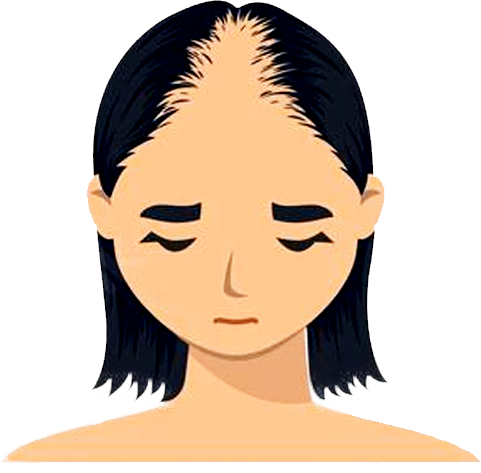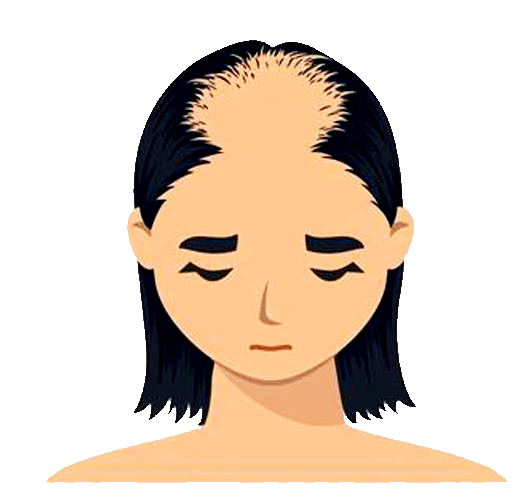Female Hair Transplant Bangladesh
Hair loss is a common problem that affects both men and women. However, it can have a greater impact on women, as it can affect their self-esteem and overall well-being.
Female pattern baldness, also known as alopecia, can cause hair thinning or telogen effluvium, particularly in young women. This condition is a major concern for many women.
Modern stressful lifestyles can have a significant impact on hair loss, leading to extensive hair loss in some cases.
It’s worth noting that female hair loss pattern differs from male pattern baldness. Women tend to experience diffuse thinning across the scalp rather than a marked hair loss pattern as seen in men.
One of the most important challenges for a hair transplant surgeon is to avoid doing a full shave or trim of the scalp hair. That’s why we offer a “no-shaven” hair transplant option for women.
Grades of Female Pattern Baldness
To determine the severity of female pattern baldness, the Ludwig scale is commonly used. This scale categorizes female pattern baldness into three stages or grades, ranging from minimal hair loss to advanced stages of baldness

Grade 1
Mild female pattern hair loss (FPHL) causes hair thinning from the mid-scalp region to the crown. Despite not being very noticeable, the first signs of thinning in this stage can be observed through the parting and curves in a distinct V shape without any deviation.

Grade 2
This type of hair loss is classified as moderate female pattern hair loss and is more noticeable. Hair thinning is noticeably visible on the scalp, starting from the mid-scalp region to the crown area, with significant hair loss. Another sign of moderate hair loss is that your hair doesn't style the way it normally does. The parting and curves in a V-shape with deviation are also indicative of moderate hair loss.

Grade 3
Female Pattern Hair Loss (FPHL) can result in the most severe type of hair loss. The thinning of hair is most noticeable on the top of the head and crown, where the scalp becomes highly visible as the hair becomes so thin that it no longer covers it.

Grade 4
Female pattern hair loss can occur in different forms, and the more advanced type is characterized by noticeable hair thinning on the top of the head or mid-scalp to crown area. The hair becomes so thin that it no longer fully covers the scalp. This is a common progression of hair loss in women, but it's important to note that hair thinning is more prevalent than total hair loss.
Female Hair Transplants
During female hair transplant procedures, it is crucial to pay attention to certain unique factors. The donor area for women is typically located at the back of their heads, and harvested hair follicles must match the natural texture and characteristics of the recipient site for a seamless and authentic appearance. To achieve a balanced and aesthetically pleasing look, a meticulous approach is required when dealing with female hair loss.
Creating the hairline is a crucial task that demands the expertise of an experienced doctor with exceptional artistic skills. The angel and director of hair play a significant role in ensuring that the result is aesthetically pleasing and natural-looking. Therefore, it is essential to choose an expert surgeon for female hair transplant procedures.
Techniques in Female Hair Transplants
2 primary techniques are commonly used
1. Follicular unit transplantation (FUT)
2. Follicular unit extraction (FUE)
Follicular Unit Extraction (FUE) is the safest and most natural option for female hair transplant, with no side effects.
The FUE Technique Has Varieties
- Sapphire FUE – the finest blade with a 0.29mm size is used for hair implantation.
- Bio FUE – a growth factor PRP solution is used for healthier hair growth.
- Big FUE – a special innovative technique or surgery of hair transplant is performed by Hairfree and Hair Clinic’s hair transplant surgeon. This technique involves using the world’s most advanced instrument, a crystal diamond sapphire blade, to achieve the perfect depth, angle, and direction while implanting the hair grafts. The most important aspect of this surgery is the use of a hypothermal solution to preserve the grafts outside the body, making it a scar-less surgery.
- Direct Hair Transplant (DHT) – This is a real-time hair transplant technique where hair grafts are implanted back into the recipient area in a very short period.





